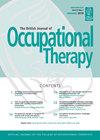莫里斯顿职业治疗结果测量法(MOTOM)是否适合用于康复服务?
IF 1.3
4区 医学
Q3 REHABILITATION
引用次数: 0
摘要
导言:《护理法案》(2014 年)要求地方当局提供复能服务,但并未对如何提供复能服务进行标准化,导致不同的服务机构采用不同的结果测量方法。本文对莫里斯顿职业治疗结果测量法进行了调查,该方法在社区可再适应设置中的研究不足。方法:我们向一个地方当局的工作人员发放了一份调查问卷,以了解他们使用莫里斯顿职业治疗结果测量法的经验。调查结果:定量调查结果显示,工作人员认为他们了解莫里斯顿职业治疗结果测量法,而且大多数受访者都认为莫里斯顿职业治疗结果测量法是一种有效的康复服务工具。定性:调查结果显示,莫里斯顿职业治疗结果衡量标准是服务使用者和服务提供者的工具,它提供了质量保证。然而,莫里斯顿职业治疗结果测量法的适用性可能会受到限制,在该地方当局中,需要进行更多培训,以提高目标评分的一致性。结论:莫里斯顿职业治疗结果测量法在可再适应服务中确实具有优势;然而,为确保其成为有效的工具,本研究强调需要进行高水平的培训。本文章由计算机程序翻译,如有差异,请以英文原文为准。
Is the Morriston Occupational Therapy Outcome Measure (MOTOM) an appropriate tool for reablement services?
Introduction:The Care Act (2014) requires local authorities to provide reablement services but does not standardise how to do this, leading to different services utilising different outcome measures. This article investigates the Morriston Occupational Therapy Outcome Measure, which has been under researched in community reablement settings.Method:A questionnaire was distributed to the staff working within one local authority to seek their experience of using the Morriston Occupational Therapy Outcome Measure. The questionnaire consisted of closed and open-ended questions to gain insights into their understanding and experience of the Morriston Occupational Therapy Outcome Measure.Findings:Quantitative findings showed that staff felt they understood the Morriston Occupational Therapy Outcome Measure, and most respondents agreed that the Morriston Occupational Therapy Outcome Measure was an effective tool for reablement services. However, staff provided contradictory responses as to whether the Morriston Occupational Therapy Outcome Measure was applied consistently or that service users understand the assessment.Qualitative:Findings showed the Morriston Occupational Therapy Outcome Measure is a service user tool, service provider tool, and it provides quality assurance. However, the Morriston Occupational Therapy Outcome Measure can have restricted applicability and within this local authority, more training was needed to improve the consistency of goal-scoring.Conclusion:The Morriston Occupational Therapy Outcome Measure does have strengths within reablement services; however, to ensure it is an effective tool, this research highlights the need for a high level of training.
求助全文
通过发布文献求助,成功后即可免费获取论文全文。
去求助
来源期刊

British Journal of Occupational Therapy
REHABILITATION-
CiteScore
2.20
自引率
15.40%
发文量
81
审稿时长
6-12 weeks
期刊介绍:
British Journal of Occupational Therapy (BJOT) is the official journal of the Royal College of Occupational Therapists. Its purpose is to publish articles with international relevance that advance knowledge in research, practice, education, and management in occupational therapy. It is a monthly peer reviewed publication that disseminates evidence on the effectiveness, benefit, and value of occupational therapy so that occupational therapists, service users, and key stakeholders can make informed decisions. BJOT publishes research articles, reviews, practice analyses, opinion pieces, editorials, letters to the editor and book reviews. It also regularly publishes special issues on topics relevant to occupational therapy.
 求助内容:
求助内容: 应助结果提醒方式:
应助结果提醒方式:


